Krala Empire: Difference between revisions
(Created page with "{{Infobox former country |native_name = Krala Empire |conventional_long_name = <!-- Full name in English --> |common_name = <!-- Name to be used in const...") |
No edit summary |
||
| Line 71: | Line 71: | ||
|symbol_type_article = <!-- Link target under symbol image. Default: Coat of arms of {{{common_name}}} --> | |symbol_type_article = <!-- Link target under symbol image. Default: Coat of arms of {{{common_name}}} --> | ||
|image_map = Krala_Empire.png | |image_map = Krala_Empire.png | ||
|map_width = 275px | |||
|image_map_alt = | |image_map_alt = | ||
|image_map_caption = | |image_map_caption = | ||
| Line 143: | Line 144: | ||
The '''Krala Dynasty''', sometimes called '''Great Kitaji''', was a state that controlled western Vedic Satria from approximately 480 to 320 BCE. Relatively little can be attested for the dynasty's found, Panghunakrala, in the archaelogical record, but his kingdom is discussed extensively in the oral tradition of the Satrian Parbhan speakers. Later figures, such as the terminal figure, Chanakyakrala, are discussed more extensively in the philosophy of successive states around Kitaji and as far away as Patharistan. | The '''Krala Dynasty''', sometimes called '''Great Kitaji''', was a state that controlled western Vedic Satria from approximately 480 to 320 BCE. Relatively little can be attested for the dynasty's found, Panghunakrala, in the archaelogical record, but his kingdom is discussed extensively in the oral tradition of the Satrian Parbhan speakers. Later figures, such as the terminal figure, Chanakyakrala, are discussed more extensively in the philosophy of successive states around Kitaji and as far away as Patharistan. The Kralas established a heavily centralized state and, in addition to semi-regular tributaries and plunder, extracted standardized taxes from multiple cities within their empire. They are the first documented monarchs to be incorporated into the concept of the {{wp|Chakravarti (Sanskrit term)|''chakravarti''}}, a monarch with supreme authority over the world (or the world of Satria). | ||
[[Category:History of Satria]] | [[Category:History of Satria]] | ||
Revision as of 00:09, 5 August 2022
Krala Empire | |
|---|---|
 | |
| Capital |
|
• c. 402 BCE | Panghunakrala |
• | ... |
• 308–313 BCE | Kaivartakrala |
• 313–322 BCE | Chanakyakrala |
| Historical era | Pre-Irfanic Satria |
The Krala Dynasty, sometimes called Great Kitaji, was a state that controlled western Vedic Satria from approximately 480 to 320 BCE. Relatively little can be attested for the dynasty's found, Panghunakrala, in the archaelogical record, but his kingdom is discussed extensively in the oral tradition of the Satrian Parbhan speakers. Later figures, such as the terminal figure, Chanakyakrala, are discussed more extensively in the philosophy of successive states around Kitaji and as far away as Patharistan. The Kralas established a heavily centralized state and, in addition to semi-regular tributaries and plunder, extracted standardized taxes from multiple cities within their empire. They are the first documented monarchs to be incorporated into the concept of the chakravarti, a monarch with supreme authority over the world (or the world of Satria).